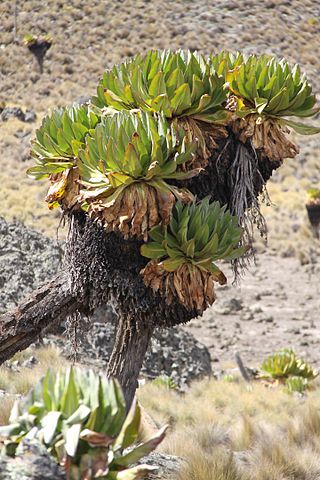
Dendrosenecio keniodendron or giant groundsel is a species of the genus Dendrosenecio of the large family Asteraceae and is one of the several species of giant groundsels endemic to the high altitudes of the Afrotropics, including Dendrosenecio johnstonii (Senecio battiscombei) occurring on Mount Kilimanjaro, Mount Kenya, and the Aberdare Mountains, Dendrosenecio keniensis occurring the lower alpine zone of Mount Kenya and D. keniodendron occurring in higher and drier sites on Mount Kenya. The giant rosette plants, sometimes 6 metres (20 ft) tall, often grow in even-sized stands, with different understory communities under different-aged stands.
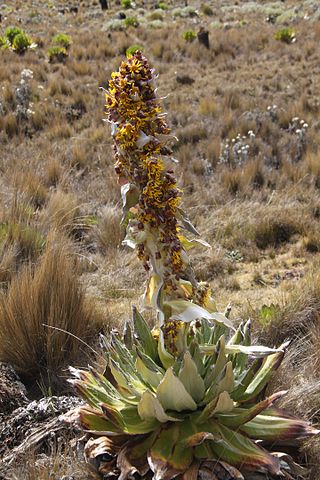
Dendrosenecio keniensis is one of the giant groundsels endemic the higher altitudes of Mount Kenya. It is in the family Asteraceae and the genus Dendrosenecio. Dendrosenecio keniodendron occurs the upper alpine zone of Mount Kenya and D. keniensis in the wetter areas of the lower alpine or the moorlands.
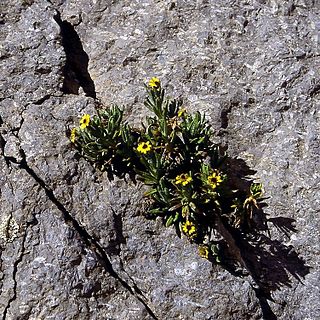
Atop of Mount Kenya Senecio keniophytum is one of the endemic groundsel (Senecio) found at high altitudes in Kenya, such as the Afro-alpine zone of Mount Kenya, but not one of the giant Dendrosenecio that also live there.

Dendrosenecio battiscombei is one of the giant groundsels that lives on the slopes of Mount Kenya and the Aberdare Range. Like Dendrosenecio adnivalis on the Ruwenzori Mountains and the Virunga Mountains, Dendrosenecio battiscombei grows in the lower wetter areas of the Afro-Alpine zone.

Dendrosenecio is a genus of flowering plants in the sunflower family. It is a segregate of Senecio, in which it formed the subgenus Dendrosenecio. Its members, the giant groundsels, are native to the higher altitude zones of ten mountain groups in equatorial East Africa, where they form a conspicuous element of the flora.

Afrosciadium kerstenii, synonym Peucedanum kerstenii, is a member of the carrot family, Apiaceae. It is native to east tropical Africa and the Democratic Republic of the Congo (Zaïre). It grows among the giant groundsels (Dendrosenecio) atop of the mountains of east Africa: Mount Kilimanjaro, Mount Kenya, Rwenzori Mountains and the Virunga Volcanoes.
Senecio maranguensis a 2-meter (6 foot) woody shrub or 6 meter (20 feet) climbing shrub from the family Asteraceae and species of the genus Senecio which makes its home at the same altitudes as the bamboo on the slopes of the mountains in East Africa.
Dendrosenecio cheranganiensis is one of the East African giant groundsel, this one endemic to the Cherangani Hills. Once it was a genus of Senecio but has recently been reclassified as a Dendrosenecio.
Dendrosenecio elgonensis is one of the giant groundsel of East Africa; this one is endemic to Mount Elgon. They used to be considered part of the genus Senecio but recently have been reclassified to their own genus, Dendrosenecio.
Dendrosenecio erici-rosenii one of the East African giant groundsel and this one can be found on the Rwenzori Mountains, Virunga Mountains and the Mitumba Mountains. It is a species of the genus Dendrosenecio and is also a collection of reclassified Senecio species.
Dendrosenecio johnstonii, formerly Senecio johnstonii, is a species of giant groundsel found in the middle altitudes of Mount Kilimanjaro in Africa. A recent botanical reclassification split off some species formerly in Senecio, putting the giant groundsels in the new genus Dendrosenecio. It also redefined the former species Senecio cottonii, as a subspecies of Dendrosenecio johnstonii. Both genera are in the family Asteraceae. The giant grounsels of the genus Dendrosenecio evolved, about a million years ago, from a Senecio that established itself on Mount Kilimanjaro, with those that survived adapting into Dendrosenecio kilimanjari. As it moved down the mountain, the adaptations necessary for the new environment created the new species, Dendrosenecio johnstonii. Various subspecies are found on other mountains.
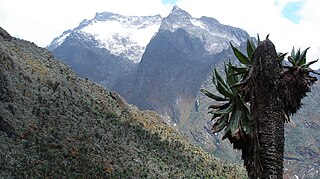
Dendrosenecio adnivalis is one of the giant groundsels of the mountains of Eastern Africa. D. adnivalis grows on the Rwenzori Mountains and on the Virunga Mountains in Uganda and the Democratic Republic of Congo.
Dendrosenecio brassiciformis is one of the East African giant groundsel, this one is endemic to the slopes of Aberdare Range and bearing fruit but once, and dying after. Once considered to be of the genus Senecio but since have been reclassified into their own genus Dendrosenecio.

The flora and fauna of Mount Kenya are diverse, due to the variation in altitude, rainfall, aspect and temperature. The mountain slopes can be divided into vegetation zones, with each zone having different dominant plant species. Although many plants on Mount Kenya have local names, here they are reported only with their English and scientific names.

The Sanetti Plateau is a major plateau of the Ethiopian Highlands, in the Oromia Region of Ethiopia. The plateau is the highest part of the Bale Mountains, and is located within Bale Mountains National Park.
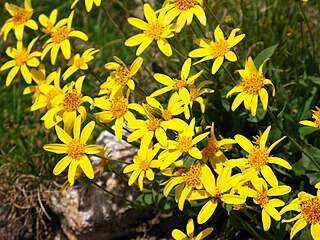
Packera werneriifolia, known by the common names alpine rock butterweed and hoary groundsel, is a species of flowering plant in the aster family. It is native to the western United States in the Sierra Nevada mountain habitat in subalpine and alpine climates, including forests and barren talus.

The East African montane moorlands is a montane grasslands and shrublands ecoregion which occupies several high mountain peaks in Kenya, South Sudan, Tanzania, and Uganda.

The Ruwenzori-Virunga montane moorlands is a montane grasslands and shrublands ecoregion of the Rwenzori Mountains and Virunga Mountains in central Africa.
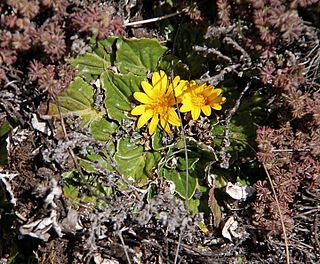
Haplocarpha rueppellii is a very low to low perennial plant with a ground rosette of entire leaves and short-stemmed, yellow flowerheads, that contain both ray and disc florets, and is assigned to the family Asteraceae. The species is an endemic of the highlands of Ethiopia and eastern Africa.
Erica trimera is a species of flowering plant. It is a shrub or tree which grows in the mountains of eastern and central Africa.












